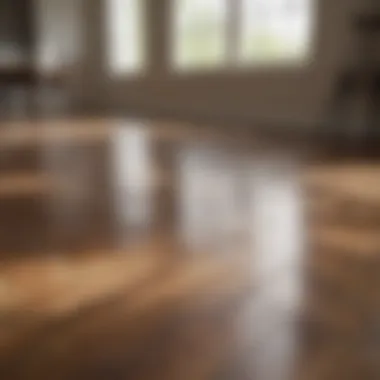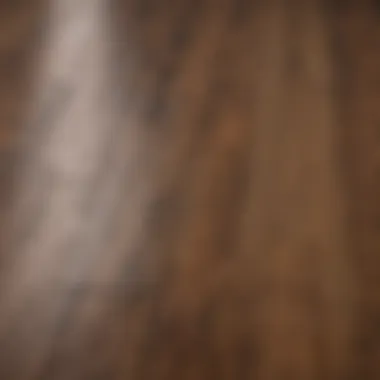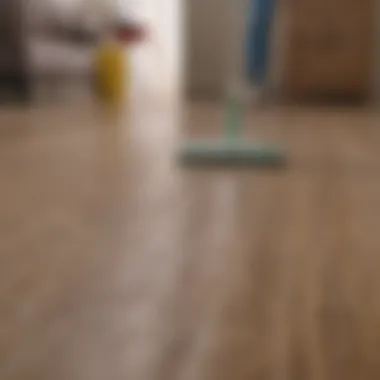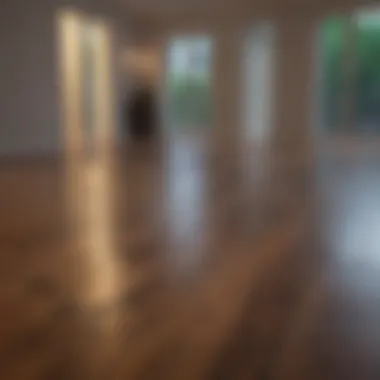Revitalize Your Laminate Flooring: Expert Tips


Intro
Laminate flooring is a favored choice among homeowners due to its durability and aesthetic versatility. However, over time, it can lose its initial beauty. This guide aims to offer an in-depth understanding of how to rejuvenate laminate flooring. We will look at common causes of wear, cleaning methods, maintenance strategies, and restoration options. Whether you're a homeowner or an interior design enthusiast, this comprehensive resource will empower you to enhance the longevity and appearance of your laminate floors.
Home Features
Architectural Styles
Laminate flooring complements a wide range of architectural styles. From sleek modern designs to rustic farmhouse aesthetics, laminate's adaptability is noteworthy. Contemporary homes might favor lighter hues and minimalistic patterns, while traditional spaces could opt for designs that mimic natural wood grains.
Interior Design Trends
In recent years, a shift toward eco-friendly materials has been evident. Many homeowners are looking for sustainable alternatives that do not compromise on appearance. Laminate flooring meets this demand, allowing for stylish designs without the use of real wood. Popular trends include larger planks and textures that enhance the realistic look of wood, appealing to modern sensibilities.
Understanding Laminate Flooring
Laminate flooring comprises multiple layers. These include a backing layer, a core layer, and a wear layer. The wear layer is critical as it provides durability and resists scratches, while the core layer contributes stability. Understanding these components helps in recognizing the flooring's response to wear and rehabilitation.
Causes of Wear and Tear
Several factors contribute to the degradation of laminate flooring:
- Foot Traffic: High levels of foot traffic can lead to scratches and dullness.
- Moisture: Laminate flooring is not waterproof. Excessive moisture can cause warping.
- Sunlight: UV rays can fade colors over time, affecting appearance.
Identifying the cause of minor defects helps in approaching restoration appropriately.
Cleaning and Maintenance Techniques
Regular cleaning and maintenance can prevent many issues from escalating. Here are some effective methods:
- Dust Mopping: Use a soft dust mop to remove loose dirt and debris regularly.
- Damp Cleaning: For deeper cleaning, a damp mop with a suitable laminate cleaning solution is effective. Avoid excess water.
- Spot Cleaning: For stains, a light scrub with a mild detergent often suffices.
It is crucial to avoid products that contain abrasive materials, as these can harm the surface.
Restoration Options
When cleaning and maintenance are not enough, consider restoration strategies. Here are two primary approaches:
DIY Solutions
For those inclined toward hands-on work, there are several DIY options such as:
- Using a Laminate Floor Restoration Kit: Many brands offer kits designed for rejuvenating the finish on laminate floors.
- Patching Scratches: Special kits can help fill in scratches effectively.
Professional Services
If your floors require more extensive work, hiring professionals might be the best route. They have advanced tools and expertise in restoring laminate flooring, ensuring better results than DIY attempts.
"Regular maintenance significantly extends the life of laminate flooring and keeps it looking fresh."
Culmination
Understanding Laminate Flooring


Understanding laminate flooring is fundamental in any discussion around maintaining and rejuvenating these surfaces. Laminate flooring has gained popularity due to its cost-effectiveness and versatility. Homeowners appreciate how it mimics natural materials like wood, while providing better resistance to scratches and moisture. Knowing the composition and structural properties of laminate flooring is essential for making informed decisions regarding cleaning and maintenance.
Composition and Structure
Laminate flooring is primarily composed of four layers. The top layer, known as the wear layer, is a transparent coating that provides scratch and stain resistance. Beneath it lies the design layer, which carries the printed image that mimics the look of wood or other materials. The core layer is made from high-density fiberboard, ensuring durability and stability. Finally, the backing layer adds moisture resistance and helps to prevent warping.
This unique structure gives laminate its strength while remaining relatively lightweight. Homeowners should recognize that this flooring type can offer impressive durability, even when compared to solid hardwood.
Durability and Maintenance
While laminate flooring is designed to withstand everyday wear and tear, it is not impervious to damage. Regular maintenance is crucial in preserving its appearance. Dirt and debris can act like sandpaper, creating scratches on the surface over time. Simple maintenance practices, like daily sweeping or vacuuming, can significantly mitigate these issues.
The lifespan of laminate flooring can vary, but with proper care, it is often expected to last for up to 25 years. One should avoid excessive water exposure as it can lead to warping. Cleaning products must be chosen wisely; harsh chemicals can degrade the wear layer and shorten the lifecycle of the flooring.
"Understanding the composition and structure of laminate flooring equips homeowners to maintain and rejuvenate their floors effectively."
In summary, a good grasp of laminate flooring's properties is indispensable. It allows for better care, increased longevity, and enhanced appearance, ensuring that the flooring remains a worthy investment for years to come.
Common Issues with Laminate Flooring
Laminate flooring is widely appreciated for its aesthetic appeal and cost-effectiveness. However, like any flooring type, it can face certain issues over time. Understanding these common problems is key for homeowners and design enthusiasts who prioritize maintaining the quality and appearance of their floors. Recognizing these issues early allows for timely interventions, which ultimately prolongs the life of the laminate.
Scratches and Scuffs
Scratches and scuffs are perhaps the most prevalent issues encountered with laminate flooring. They can arise from a variety of sources, including furniture placement, pet claws, or even heavy foot traffic. These imperfections not only detract from the floor's visual appeal but can also lead to more significant damage if left untreated.
To address scratches, a common recommendation is to use a scratch repair kit designed specifically for laminate. These kits often include markers or crayons that can blend the scratch with the surrounding area. In more severe cases, replacing planks might be the only viable option. Regular care, such as sweeping or vacuuming, can help reduce the accumulation of dirt and debris that exacerbates the risk of scratching.
Fading and Discoloration
Another issue that affects the longevity of laminate flooring is fading and discoloration. This can occur due to prolonged exposure to sunlight, which breaks down the laminate's surface layers. The aesthetics of a room can be severely compromised when the flooring loses its vibrancy, leading to an uneven appearance.
Preventative measures are essential in combating this issue. Homeowners can use window treatments, such as curtains or blinds, to limit direct sunlight onto the floor. Additionally, a quality laminate with UV protection can help shield the surface from fading. Regular cleaning also prevents dust and dirt buildup that can contribute to a faded look.
Moisture Damage
Moisture damage is a significant concern for laminate flooring, as it is not inherently waterproof. Water spills or humidity can lead to warping, buckling, and separation of the laminate layers. Bathrooms and kitchens, where moisture levels are higher, are particularly vulnerable.
To mitigate the risk of moisture damage, it is crucial to quickly clean up spills and avoid excessive water exposure. Using floor mats in areas prone to spills is an effective way to protect the laminate. Moreover, ensuring proper ventilation helps to reduce humidity levels in the air. In cases of existing damage, consulting a flooring professional may be necessary to assess the extent of the issue and recommend appropriate remediation techniques.
In summary, maintaining laminate flooring involves prompt attention to common issues such as scratches, fading, and moisture damage. Implementing preventative measures can greatly enhance the durability and longevity of the flooring, preserving its aesthetic value for years.
Cleaning Techniques for Laminate Flooring
Cleaning laminate flooring is essential to maintain its aesthetic appeal and functionality. Proper cleaning methods not only enhance the look of the floor but also extend its lifespan, making it a valuable investment for homeowners. Laminate flooring is known for its resilience, but neglect can lead to permanent damage. The importance of systematic cleaning techniques cannot be overstated when it comes to preserving the appearance and durability of your floors.
Daily Cleaning Practices
Daily cleaning practices serve as the first line of defense against dirt and grime accumulation. Simple techniques can significantly mitigate wear and tear. Sweeping or vacuuming the floor every day can prevent debris from scratching the surface. A soft-bristle broom or a vacuum with a hard floor setting is recommended for this task. It is important to avoid excessive moisture when cleaning laminate floors. Using a damp mop once a week can help to remove any stubborn spots without risking water exposure that could warp the flooring.
Here are tips for daily cleaning:
- Sweep Regularly: Removes dust and small particles.
- Use a Vacuum with Soft Brushes: Avoids scratching the surface.
- Damp Mop Weekly: Helps to refresh the floor without soaking it.


Deep Cleaning Solutions
Deep cleaning is necessary to address built-up dirt and stubborn stains that routine cleaning may not remove. An effective deep cleaning solution can involve a mixture of vinegar and water. However, users must be cautious with vinegar as it can be too acidic for certain flooring types. It is wise to test any solution in a small, unobtrusive area first. Specific deep cleaners designed for laminate flooring are also available and can provide effective results. The application can be done using a spray bottle for even distribution, followed by mopping up after a short dwell time.
A step-by-step guide for deep cleaning includes:
- Prepare a Cleaning Solution: Mix vinegar and water or use a commercial laminate cleaner.
- Apply with a Spray Bottle: Lightly mist the floor for better control.
- Mop Thoroughly: Ensure the mop is damp but not soaking.
- Dry the Floor: After cleaning, ensure proper airflow to dry the floor.
Avoiding Harmful Chemicals
Choosing the right cleaning products is crucial to maintain the integrity of laminate flooring. Harsh chemicals can cause irreversible damage. For instance, products containing ammonia, bleach, or wax should be strictly avoided. Labels should be carefully examined to ensure that only safe cleaners are used. Opting for natural alternatives like soap and water or dedicated laminate floor cleaners can yield excellent results without the risk of damage.
Consider the following when selecting cleaning products:
- Read Labels Carefully: Look for safe materials.
- Natural Alternatives: Vinegar and mild soap solutions are viable.
- Avoid Wax-Based Cleaners: They can leave residues that trap dirt.
"Quality cleaning techniques are essential for maintaining the beauty and longevity of laminate flooring. Regular attention can prevent significant issues in the future."
By combining daily practices with deep cleaning solutions and being careful with cleaning products, homeowners can significantly improve the appearance of their laminate flooring. Caring for these surfaces thoughtfully is a method to enjoy them for years to come.
Restoring the Appearance of Laminate Flooring
Restoring the appearance of laminate flooring is an essential aspect of maintaining its aesthetic appeal and ensuring its longevity. Over time, wear and tear can diminish a floor’s appearance, making it less inviting and more prone to damage. By focusing on restoration techniques, homeowners can revitalize their laminate floors, enhancing both functionality and aesthetics. A well-maintained laminate floor reflects on the overall interior design of the home, contributing to its value and ambiance. This section outlines various methods to restore laminate flooring effectively.
Using Scratch Repair Kits
Scratch repair kits are a practical solution to address minor abrasions on laminate flooring. Typically, these kits include markers or pens designed to fill in or camouflages scratches, restoring a smooth and uniform look. Here are key benefits and considerations when using scratch repair kits:
- Ease of Use: Most kits come with straightforward instructions, allowing homeowners to implement repairs without professional assistance.
- Quick Fix: They offer a quick way to improve the appearance of the floor, making scratches less noticeable almost instantly.
- Color Variety: Repair kits often include various colors to match different laminate finishes.
However, it is important to select the right kit that corresponds to your laminate’s color and finish.
Applying Laminate Floor Polish
Laminate floor polish can greatly enhance the gloss and overall appearance of the flooring. This step is particularly useful after cleaning, as it adds a protective layer over the surface. When applying laminate floor polish, consider the following aspects:
- Pre-Application Cleaning: Always clean the floor thoroughly before applying polish. Dirt and debris can interfere with adhesion and finish.
- Application Technique: Use a clean, flat applicator designed specifically for laminate flooring to ensure an even distribution of polish.
- Frequency of Use: Regular polishing can extend the life of the floor, but over-polishing may cause build-up, requiring periodic stripping.
"A well-polished laminate floor can reflect light beautifully, giving a space a spacious feel."
Leveraging Home Remedies
Home remedies can be effective for rejuvenating laminate floors without the need for commercial products. While not as conventional, they often utilize common household items that are safe and inexpensive. Here are some popular home remedies for restoring laminate flooring:
- Vinegar and Water Solution: A mix of vinegar and water can clean surfaces effectively while adding shine. Be cautious about the amount of vinegar used, as excess acid might harm the floor.
- Olive Oil and Vinegar Mix: This solution can be used as a polish, adding a subtle shine to the floor while helping to repair minor scratches.
- Baking Soda Paste: This can combat persistent stains. Mixing baking soda with water into a paste and applying it gently can lift away stubborn blemishes.
Each method is simple yet offers an effective way to enhance the appearance of your laminate flooring, ensuring it remains an attractive feature in your home.
Preventative Measures to Extend Laminate Flooring Life
Preventative measures are crucial for extending the life of laminate flooring. Unlike hardwood, laminate requires specific actions to maintain its aesthetic and structural integrity. With proper attention, laminate floors can remain visually appealing and durable over time. When homeowners implement these measures, they not only enhance the flooring's longevity but also reduce the need for intensive cleaning or costly repairs later.
Choosing Appropriate Rugs and Mats


Using rugs and mats strategically can protect laminate flooring from excessive wear. Choose mats that have non-slip backing to prevent unnecessary movement, which could lead to scratches. Place these mats at entry points to trap dirt and debris before it reaches the floor.
Additionally, consider using area rugs in high-traffic zones. These rugs can act as a barrier against scuffs and scratches while adding a decorative touch to the interior. It's important to ensure that the rugs do not have a rubber backing, as this can trap moisture and create damage beneath them.
- To summarize, the benefits include:
- Protection against dirt and scratches.
- Enhanced aesthetic appeal.
- Increased comfort underfoot.
"A simple change like strategically placing rugs can significantly reduce wear on your laminate flooring."
Implementing Proper Furniture Pads
Another effective preventative measure is the use of furniture pads. These small but significant objects help distribute the weight of furniture, preventing heavy items from denting or scratching the laminate surface. Use felt pads under all furniture legs, including chairs, tables, and sofas.
Regularly inspect these pads for wear and tear. If they become worn or damaged, replace them immediately. Ignoring this could lead to significant damage over time, as exposed furniture legs can easily scratch or gouge the laminate.
- The advantages of using proper pads include:
- Minimizing risk of scratches.
- Preventing dents from heavy furniture.
- Simplifying movement of furniture when rearranging or cleaning.
By focusing on these preventative measures, homeowners can maintain the appeal and functionality of their laminate flooring, ensuring it remains a valuable asset in their home for years to come.
When to Consider Professional Help
Assessing the state of laminate flooring can be a challenging task. Many homeowners try to handle damage on their own, believing that a simple repair or cleaning will suffice. However, there are instances where professional intervention is not only beneficial but necessary. The expertise of a professional can lead to better results, saving time and potentially more extensive repair costs in the future.
Assessing Damage Severity
Determining the severity of damage is critical before deciding whether to seek professional services. Small scratches and scuffs may be easily remedied with at-home solutions, such as scratch repair kits or polishing applications. However, when damage extends beyond aesthetic concerns—such as warping or significant moisture exposure—the need for professional assessment becomes paramount. Signs that suggest severe damage include:
- Visible Warping: Floors that buckle, bulge, or have uneven surfaces indicate serious structural issues.
- Water Damage: If laminate flooring has experienced prolonged exposure to water, it can develop mold or mildew. This is a situation that requires a thorough examination by a professional.
- Persistent Discoloration: If areas of the floor remain discolored despite cleaning efforts, this may signal deeper issues related to the material's integrity.
- Lifting Edges: If the edges of boards are lifting, it is a sign of underlying problems that often need professional solutions.
Understanding Restoration Services
Choosing to engage a professional means understanding the restoration services available. Different professionals may specialize in various aspects of floor care. It’s important to identify what services they provide and how these can address the specific issues faced by your laminate flooring. Common services include:
- Deep Cleaning: Professionals use specialized tools and methods to thoroughly clean laminate, restoring its original sheen.
- Water Damage Restoration: Experts assess moisture damage and can apply drying procedures to minimize further issues.
- Replacement of Sections: In severe cases, professionals can replace damaged individual planks without needing to replace the entire floor.
- Refinishing: Some specialists may offer refinishing services that can rejuvenate the look of the flooring, extending its lifespan.
Evaluating Replacement Options
When it comes to laminate flooring, understanding when it is time to consider a replacement is paramount to preserving both the aesthetics and function of your space. Over time, even the most durable laminate can exhibit signs of wear that may require more than just a simple cleaning or minor repairs. Evaluating replacement options not only addresses deeper issues but also rejuvenates the overall ambiance of your home.
Identifying Signs for Replacement
Several indicators suggest that your laminate flooring might no longer be fit for service. Key signs include:
- Severe Damage: Large cracks or gouges make the floor less safe and unattractive.
- Water Damage: If you notice warping or swelling, this often suggests moisture has breached the protective surface.
- Persistent Scratches: Deep, unremovable scratches may indicate that the floor’s protective layer has worn down.
- Fading Color: If your laminate has lost its vibrancy, this could affect your home's curb appeal.
It is essential to look out for these signs actively. Ignoring them could lead to further deterioration and more costly interventions later down the line.
Choosing Modern Alternatives
If the decision to replace has been made, exploring modern alternatives is next. The market today offers a range of innovative products designed to elevate both performance and aesthetics:
- Luxury Vinyl Plank (LVP): Known for its water resistance and durability, LVP can mimic the look of natural wood or stone.
- Engineered Wood: Provides the warmth of real wood but is more adaptable to varied environments.
- Bamboo Flooring: An eco-friendly option, bamboo has impressive durability and is increasingly popular.
- Cork Flooring: This offers excellent sound insulation and comfort and it is also a sustainable material.
Selecting the right type of flooring will depend on personal preferences, the function of the room, and budget constraints. Considerations such as foot traffic and potential moisture exposure should weigh heavily in decision-making.
"Replacing laminate flooring can not only improve aesthetics but also increase the property's value if chosen wisely."
By critically evaluating the need for replacement and navigating modern alternatives, homeowners can ensure their spaces remain both functional and appealing. The right choice can make a significant difference in the long-term maintenance and enjoyment of your flooring.















